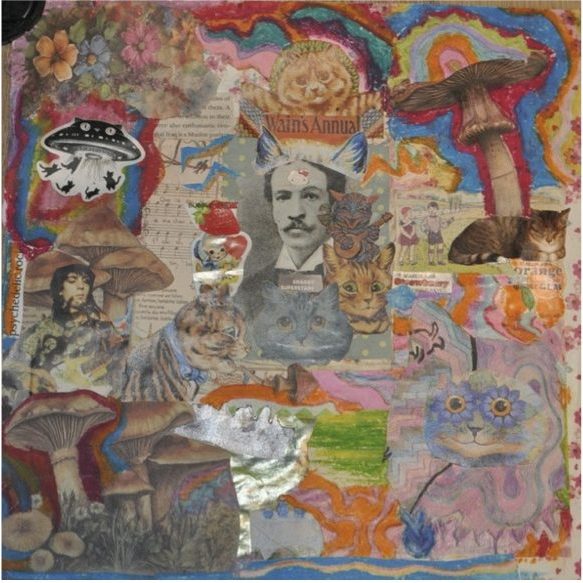
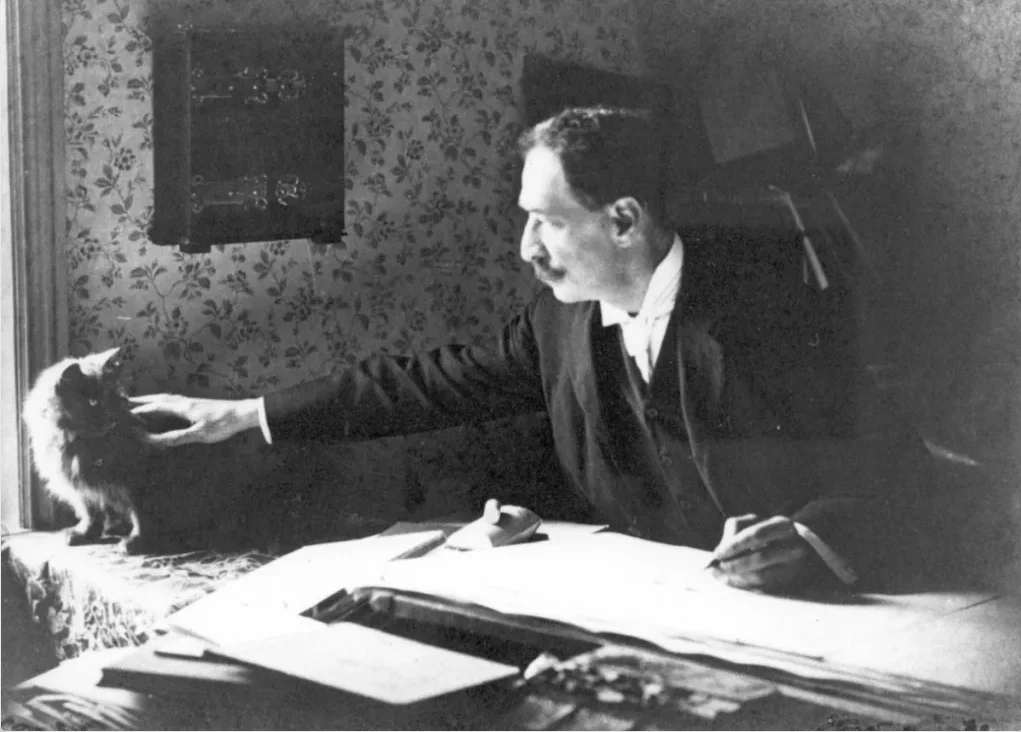
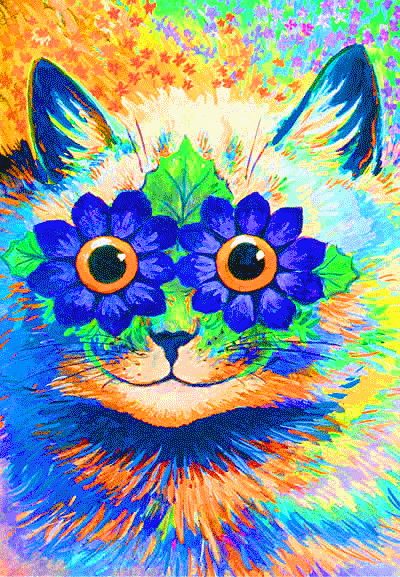
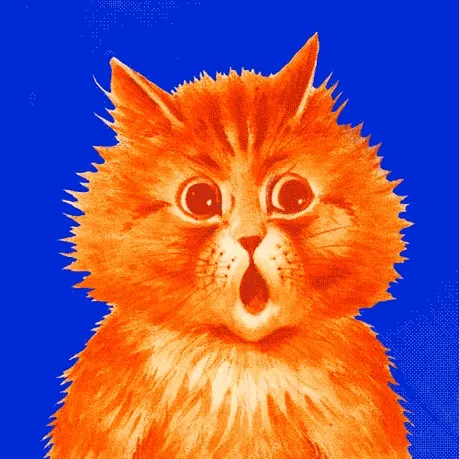
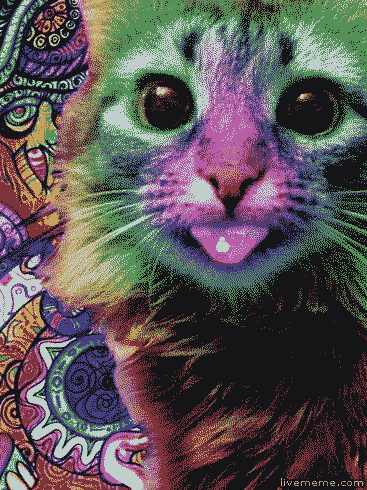
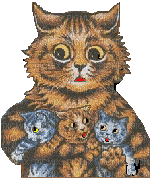
“He has made the cat his own. He invented a cat style, a cat society, a whole cat world,English cats that do not look and live like Louis Wain cats are ashamed of themselves”
– HG Wells

Louis Wain is one of the most, distinctive artist among Victorian Painters merely for his fluffy subject matters. His use of anthropomorphized animals have been credited as later inspiration for animation studios like Pixar and Disney. At paramount were his depictions of wonder-eyed, anthropomorphic cats indulging in lavish activity typical to that of Victorian England. strolling along the country, playing cricket on a sunny day, and getting into trouble.
Although Louis Wain has become far more known for his later depictions of psychedelic cats, which have been wrongly attributed to his declining mental state. This theory of mental degradation is mostly attributed to Francis Reitman’s “psychotic art” book as well as Walter Macray, a psychologist who in 1938, used Louis Wain’s art to support his theory of artistic deterioration. Although it’s still uncertain the diagnosis of Louis’s illness, yet still, the dramatization of his health has always been more of a way of sensationalizing rather than deciphering the mind of someone as fascinating as Wain.
Louis’s depictions of Catland were created to escape the life marred by personal tragedies, loss, and childhood isolation. One of the front figures of Outsider art, as well as a proponent that later fueled the psychedelia movement in the 60s. You could probably make comparison to the singer Syd Barret of Pink Floyd, an English singer who was known for his struggles with schizophrenia. If you listen to much of Pink Floyd’s early albums, specifically Piper at the Gates of Dawn, the imagery almost recalls something Wainian; Just imagine , “Lucifer cat” plays, as an almost exhibitable quant English dinning room is melted into a trail of vibrant colors, slowly the distorted paisley wall, licked with arsenic, distorts into wavy patterns, and turns into the lynx-eyed face of one of Louis Wain’s abstract cats.
. .“The days of my childhood were terrifying in the extreme. I seemed to live hundreds of years, and to see thousands of mental pictures of extraordinary complexity, pictures that were so vivid that I can recall many of them in the present day. […] But above all, I was haunted; in the streets, at home, by day and night, by a vast globe, which seemed to have endless surface, and I seemed to see myself climbing over and over it, until, from sheer fright I came to myself, and the vision went.”
As a boy, my fancy trembled in the balance between music, painting, authorship and chemistry. I might in one sense say that I have had an art training, for I never contemplated being anything but an artist in one form or another”
Louis Wain was born August 5th in Clerkenwell London, the only boy of six sisters, and a family plagued by mental illness. His father was a textile trader, and his mother a carpet embroider. Loui’s life had started with hardship, he was born with a cleft lip, afflicted with visions, and faced numerous health issues, including scarlet fever. As a result, Louis was forced to stay homebound for an extensive period of time. He would not attend school until he was 10 years old. This isolation would result in Louis’s withdrawn and shy personality, and even when accepted back into Orchard Street Foundation school, Louis remained a truant, skipping his classes and wandering the streets. Oddly enough, he cared about learning everything but his academics. While skipping, he observed the life around him, attending lectures or exploring the countryside. much of his joy in this time was from drawing, music, and learning from science lectures at the Royal Polytechnic Institution. Louis would eventually pursue his passion at the West London School of Arts. While here, Louis Wain would begin his career in art journalism, although at 20, the death of his father left Louis as the only male to financially support his mother and sisters. His skills and ambition were recognize by the West London School of Arts, and in 1881, he was given an opportunity to work there as a teacher’s assistant.
Not much is mentioned of Louie’s beginning as a press artist, which, may be because of how simplistically natural his work was compared to his later works; ambitious and colorful prints inspired by the blooming art nouveau movement. yet still, Louis provided his interest in nature of all kinds, he specifically specialized in animals and pastural scenes. Louis would even go on long train rides to attend animal circus shows for drawing scenes. In 1881, 22 year old Louie’s, first non-feline print was published by The Illustrated Sporting News. Louis’s high attention to detail was desecrated when a printer mistakingly titled his work “Robin’s breakfast” a printing error would embarrass him tremendously. Despite this, Louie continued to do work for the Illustrated sporting News, eventually leaving his teaching occupation to work as a full-time staff there. Three years later, the magazine would published Louis Wain’s first drawing of cats, called “The Domestic Cat”a playful infographic on feline domestication. Although this print, adoring and charming depictions of cats in their natural habit, had not yet obtaining the humanistic charm of his later work.In 1886, Louis would be commissioned to illustrate a book titled “Madame Tabbies Establishment” a children’s book written by Caroline Hughes telling the story of a school for kitten manners. The online archive shows a simple blue hardback book llustrated with numerous golden prancing kittens by Louis Wain, as well as his ornate and meticulous design work, effective as ornate memorabilia.
Louis Wain entered a relationship with his sister’s governess, Emily Richardson, who was employed in the Wain’s household. Emily was of lower class and 10 years his age, which at the time was seen as scandalous when most gaps in marriage were an average of four years. Despite this, Louis and Emily would get married months later, and they would later move into their own home. Emily brought kindness and encouragement into the life of a man who had a gift not yet shared to the world. She encouraged Louis to publish his first big success, “Kittens Christmas.” Unfortunately, the publishing of his success was overshadowed by tragedy, when in 1887, Emily would pass away to breast cancer. there was no denying how meaningful Emily had been to Wain. She profoundly affected his art. Her death greatly devastated him, tearing a hole into the once whimsy man. Wain dedicating the rest of his craft to her memory, and would never marry again. During Emily’s days, spent sickly and bedridden, came the cat “Peter” who, had peacefully kept her company in her illness. Given by one of Louis’s sister, (Or found as a stray during the night, most articles and sources conflict,) to keep her comfort in time of pain. Peter the cat was featured numerously as a model, serving as inspiration in his beginning works for feline personality. To Louis Wain, the happiness Peter provided Emily in those last days, inspired him to create his endearing cats.

“Peter” as shown in one of Louis’s cartoons.
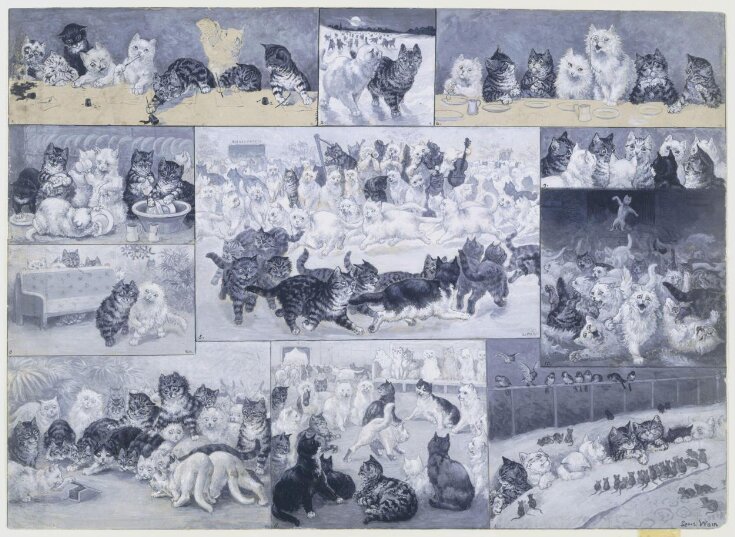
From “A Kitten’s Christmas Party” 1886 Illustrated London News, Christmas issue, pencil and wash. The publishing would soon take over England and begun their interest in Catland.
The cat craze begin with the publishing of “A kitten’s Christmas Party” commissioned by Sir William Ingram, for the Christmas volume of the Illustrated London News. What would be Wain’s first depiction of his signature anthropomorphic cats that defined him. This 10-panelled print depicts the emergence of humanly character from Louis’s kittens, which are portrayed in different lively activities, messily indulging in punch, writing letters, running in circles, and being curious.
The years following 1890 served to be a flourishing time for Louis, despite the tragedy of his wife’s passing still lingering. Following the success of “Kittens Christmas” Louis was commissioned for many children’s books, such as “Fairy tales” in 1895 and then “Puss in Boots” aswell as “cats cradle”In 1908. Louis illustrated a fantasy world of animals for children, much different from the modest and disciplined rhymes of English children books of the time, which put emphasis on manners and discipline. His cats themselves very much catered to the undiscipline. “Cat Scouts” from 1911 tells of a group of cat scouts getting into misfortunes. A mischievous cat named “tiresome Teazer” as well as a naive cat scout named Timmy who accidentally “blows himself to the sky” while trying to make gunpowder, accompany this story.



“The cat scouts” 1911 Illustrated by Louis Wain, written byJessie pope, Published by Blackie and Son
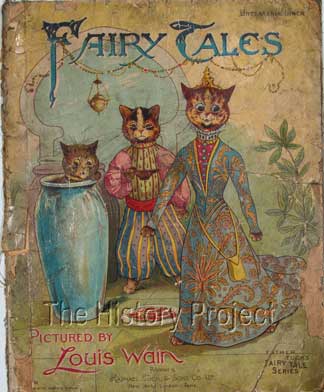
Fairy Tales 1895 1895 illustrated by Louis Wain published by Raphael and Sons
”Trip through fairyland, featuring Puss-in-Boots, witches, dwarves, and more.” — Description from “Catland” Wepage

Pussies at Wonderland” 1900 illustrated by Louis Wain published by Raphael and Tuck
From 1900, Louis was producing 600 average new designs per year. His anthropomorphized cats were widely circulated from illustrated newspapers, postcards, coloring books, and magazines. Louis was a national sensation for a long time. He even held his own “Louis Wain’s annuals,” Lasting until 1915. Advertisements used his cats indulging their products, even his likelihood was used, such as in a tonic medicine advert where Louis wain is seen holding a black cat while text below show him praising phospherine tablets. He transformed the Victorian image of cats, from vermin chaser to pristine clean creatures, as supported by the use of his cats in cleaning advertisements. He judged cats for cat contests, even becoming the chairman of the Cat Club. Louis Wain kept true to his altruistic personality, a compassionate outlook gained from his childhood interest of learning the cultures around him, donating much of his earnings to charities helping stray cats. He even joined the anti-vivisection club. Although Louis’s reckless generosity, when it came to money, would end up being a contribution to his eventual financial struggle.

The medal given to Louis Wain from the National Cat Club
Louis popularity coincided with the expansion of the commercial print market in the development of color reproduction. Color so vividly played a part in his work, such as in “Three cats performing a song” a quintessential example of his anthropomorphic creatures, english dressed cats wearing tuxedos and petticoats. His cat became increasingly expressionistic. Blue tabbies sipped tea, and wore refined overcoats, vibrant cats partaking on Countryside strolls, “Catland” soon took over the hearts of England. Catering to their fantastical ideals of embellishments-yet still, being observational, Louis parodied the life of this society. A man who took in everything from the world, he observed causal human endeavors in public, using these humanistic poses as fuel for his cats.
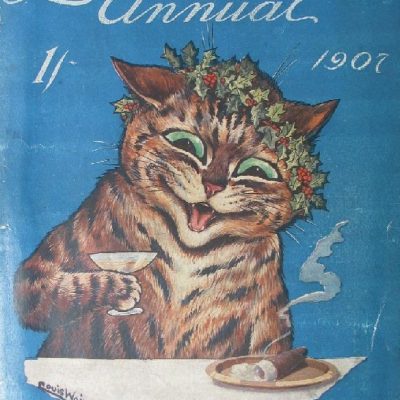
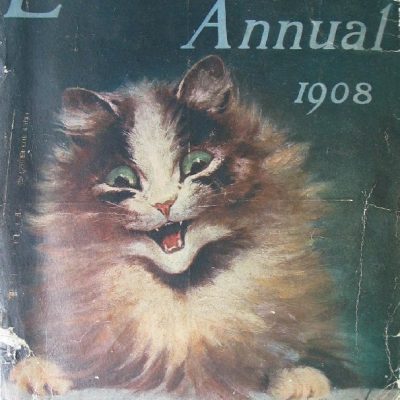

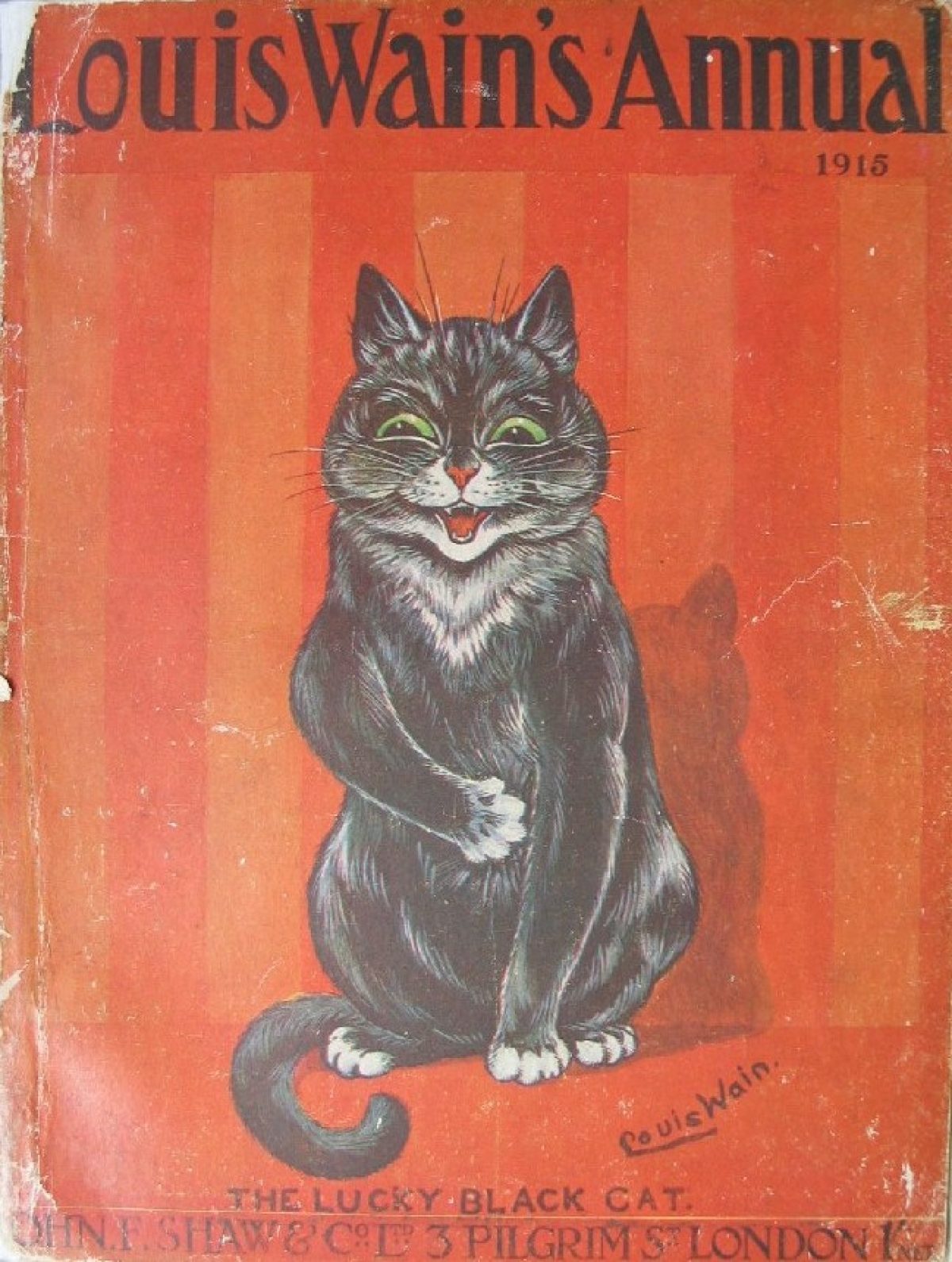
Louis Wains annuals
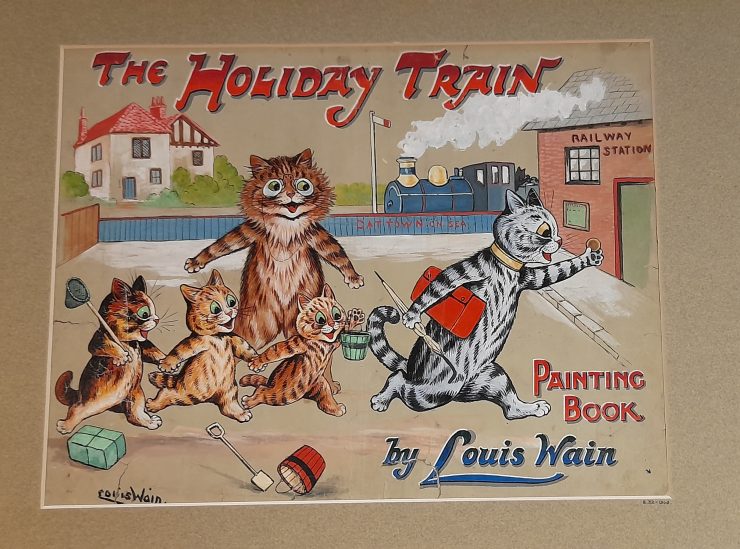

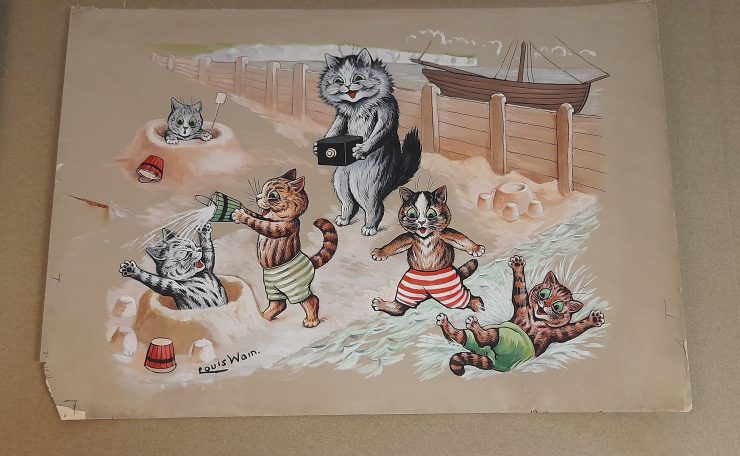
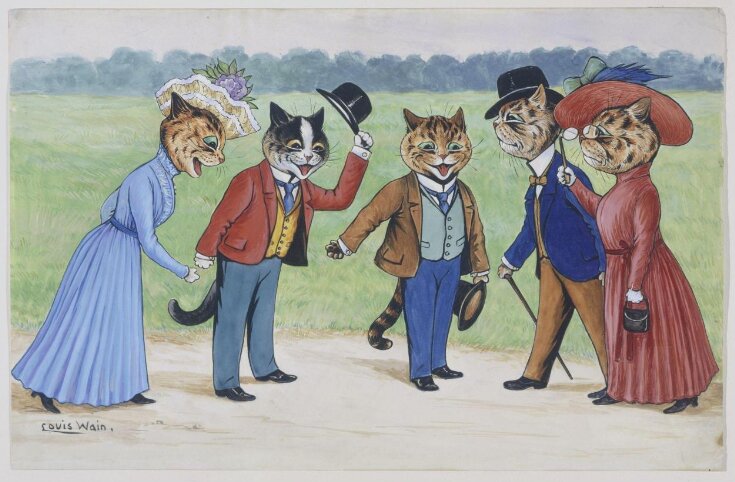
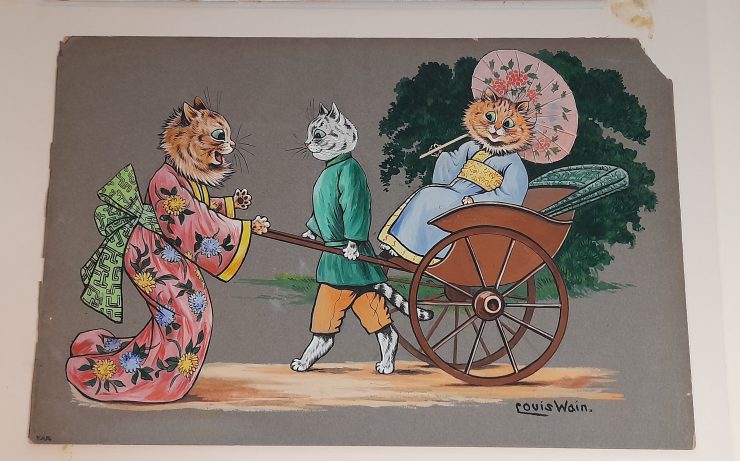
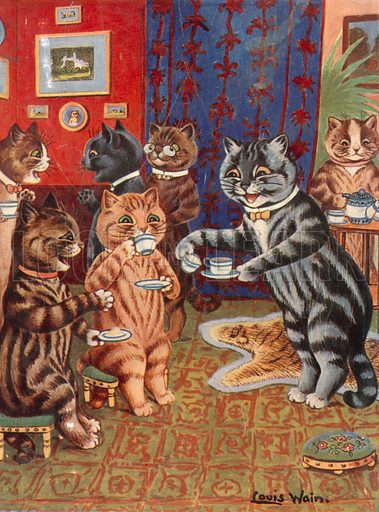
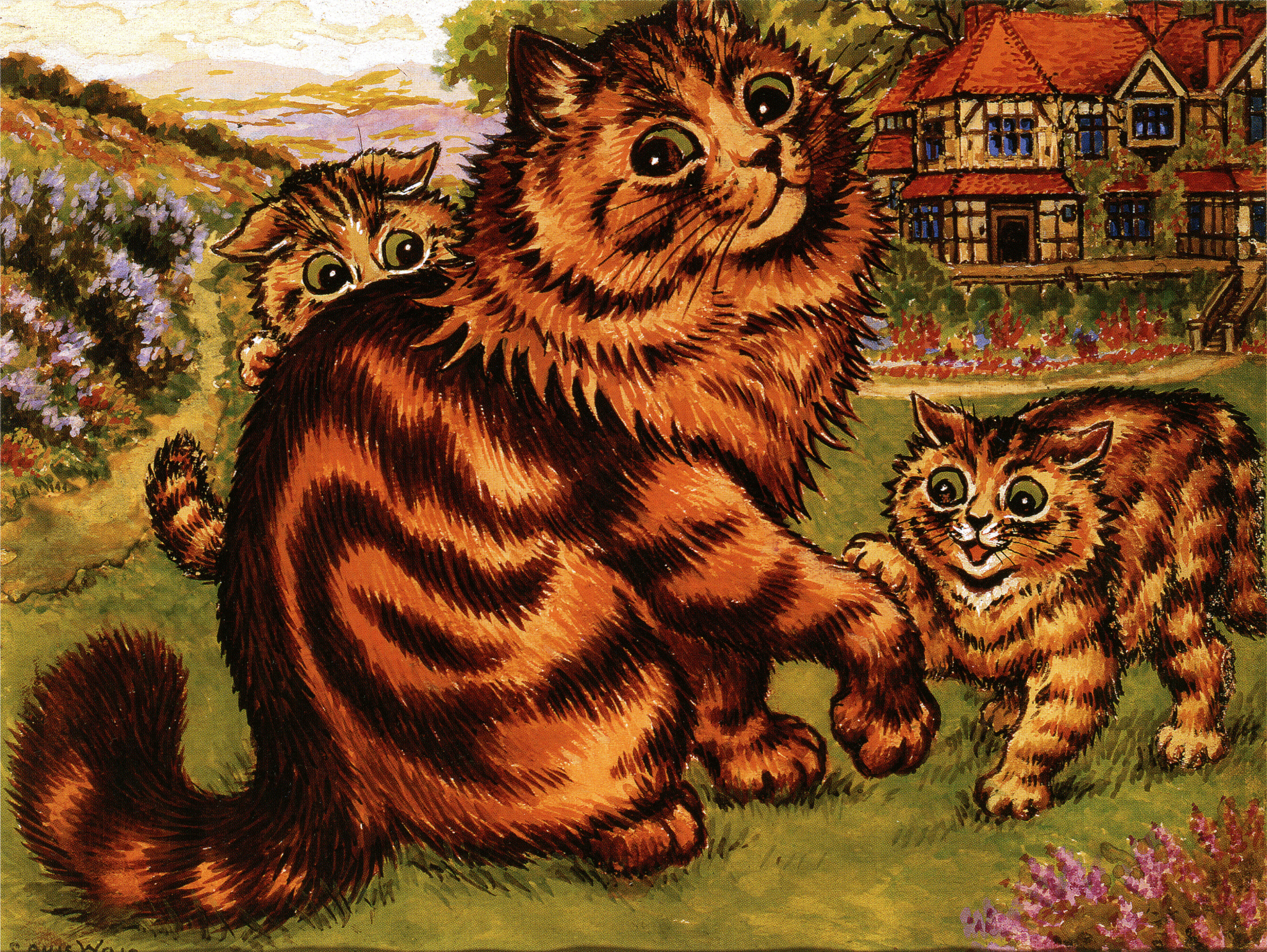
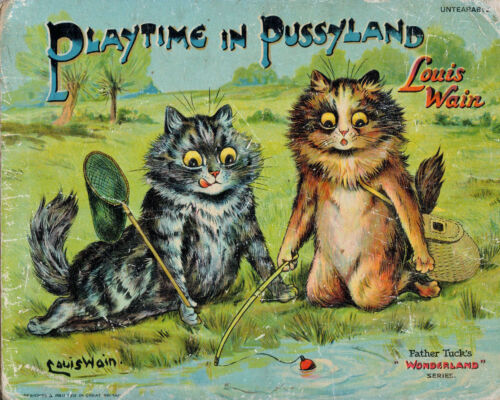
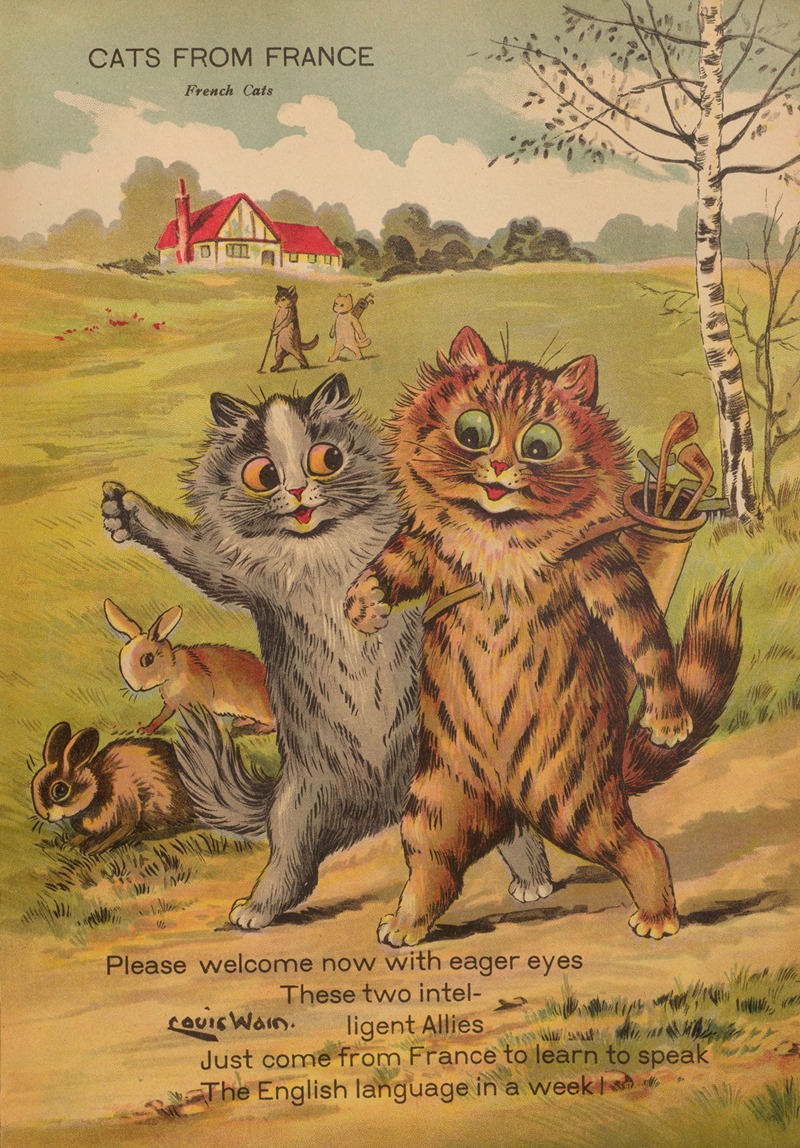
‘too true an artist to have professional affectations or conceits’, dashed off a cat with ‘marvellous […] rapidity and ease’, all the time spouting the conviction that ‘our English cats are slowly but surely developing into stronger types […] the face becom[ing] condensed, as it were, into a series of circles.
People were intrigued by Lewis Wain. He was an eccentric man with unbelievable ability. He was known for using both his hands simultaneously to create a drawing, resulting in his countless rapidly produced illustrations. He was a visonary, creating vibrant fun cats for the public to observe in wonder, all while wondering people with his words alone. His extreme ideals and peculiar theories on cats would soon become a main center of marvel. His theories that cats fur were controlled by electric currents to the north pole had probably been influenced by his interests in science. Besides his love of art one of his other less mentioned passions were science and music.There is a slight connection to Louis’s belief that cats extruded electric currency and his interest in Tesla and his current theories of electricity. There is evidence Louis Wain enjoyed futurism composers of the time. Louis Wain played piano himself.
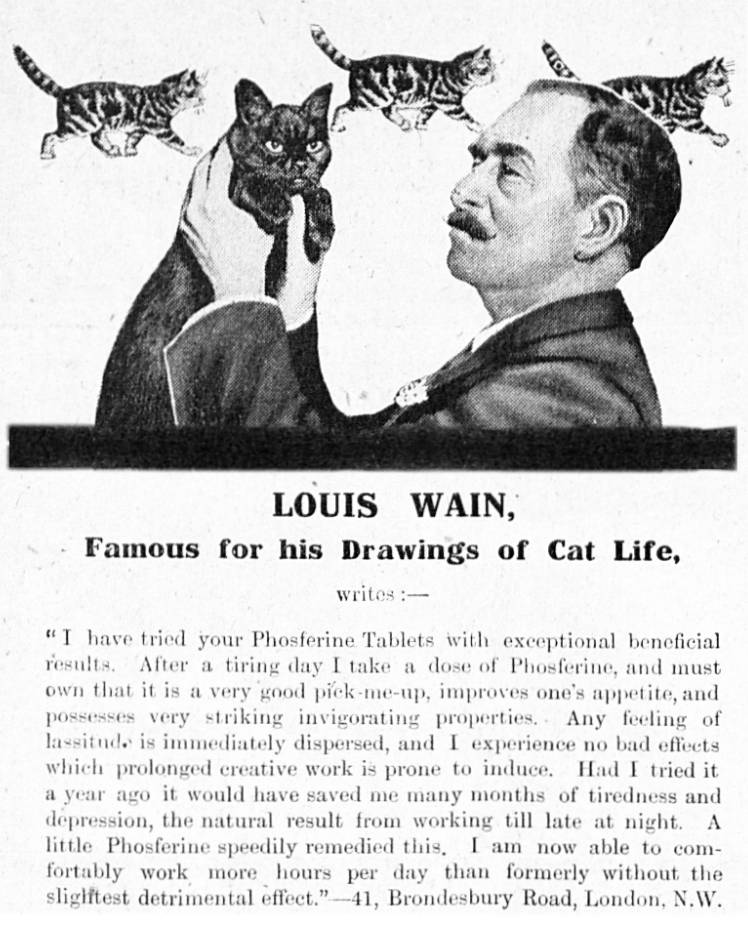
an advertisement for Phospherine tablets containing Louis review

“Love’s young dreams” J. Beagles postcards.
The feline gaze

“there’s a dark young man who loves you” J. Beagles postcards
Louis Wain would provide cat illustrations to service worker, children and soldiers as comfort, but later he would have to pay for his utility and services this way. Louis Wain, despite his fame, never really got to enjoy the money he earned, as much of it went to his sister. Although 1900 to 1910 served to be the best years of Lewis Wain despite the death of his wife, there were marks of tragedy in the life of the feline aficionado. Marie, Wayne’s youngest mentally ill sister was finally declared insane in March 1901 and her mental condition corroded gradually until her death in 1913. No one in the Wain family whatever mention her name. Not even Louis. An isolating fate which would almost take him in his last years alive. Although Louis was becoming a national sensation, he unfortunately did not have the business skills to sustain himself, and he was especially prone to being taken advantage of by scammers. His shyness and difficulty with human contact made the much needed confrontation of business and negotiation difficult for him.
Many relate the concurrence of Louis’s degrading mental state with his increased experimentation, although there are examples prior in his career that Louis was already experimenting before his decadence. Much of these were met with financial setback and poor return. Among pastel, watercolor, pencil and print, Louis dabbled briefly into ceramics as well as animation.
In 1914, Louis Wain would start a rough sketch for a series of nine porcelain animals. Meant as lucky mascots and flower pots, he called them the “Futurist Cats.” He based their aesthetics off of the Cubist art movement- composing vibrant bodies of symmetrical shapes and fluid pattern on the skin of glazed felines, aswell as other characters, such as “The Lucky Bulldog” and “the Lucky Pig” who feel out of place for being in the midst of Edwardian elegance. One cat called “The lucky black cat” is detailed as ”Hold on to me and fortune will smile on thee”.
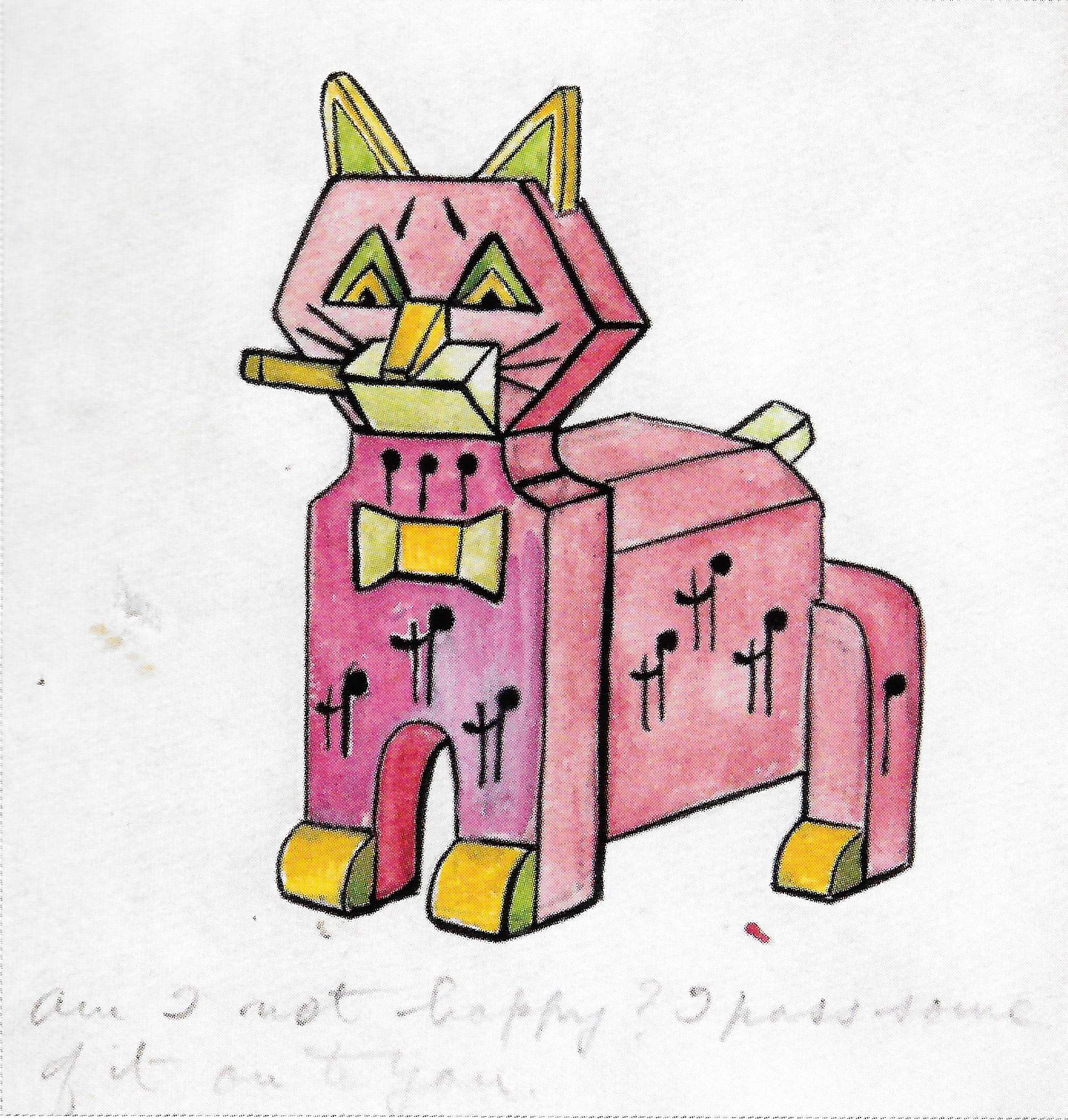
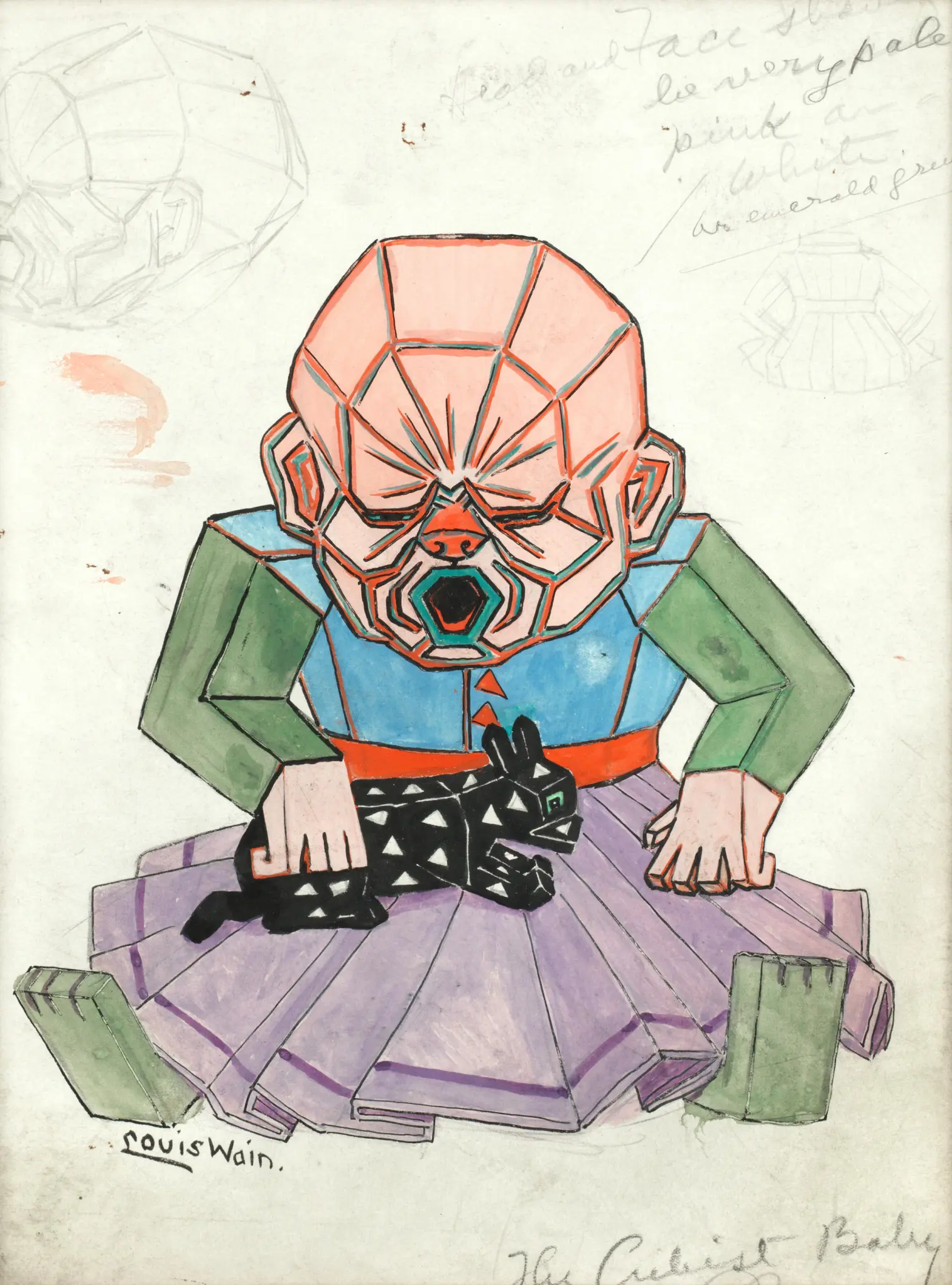
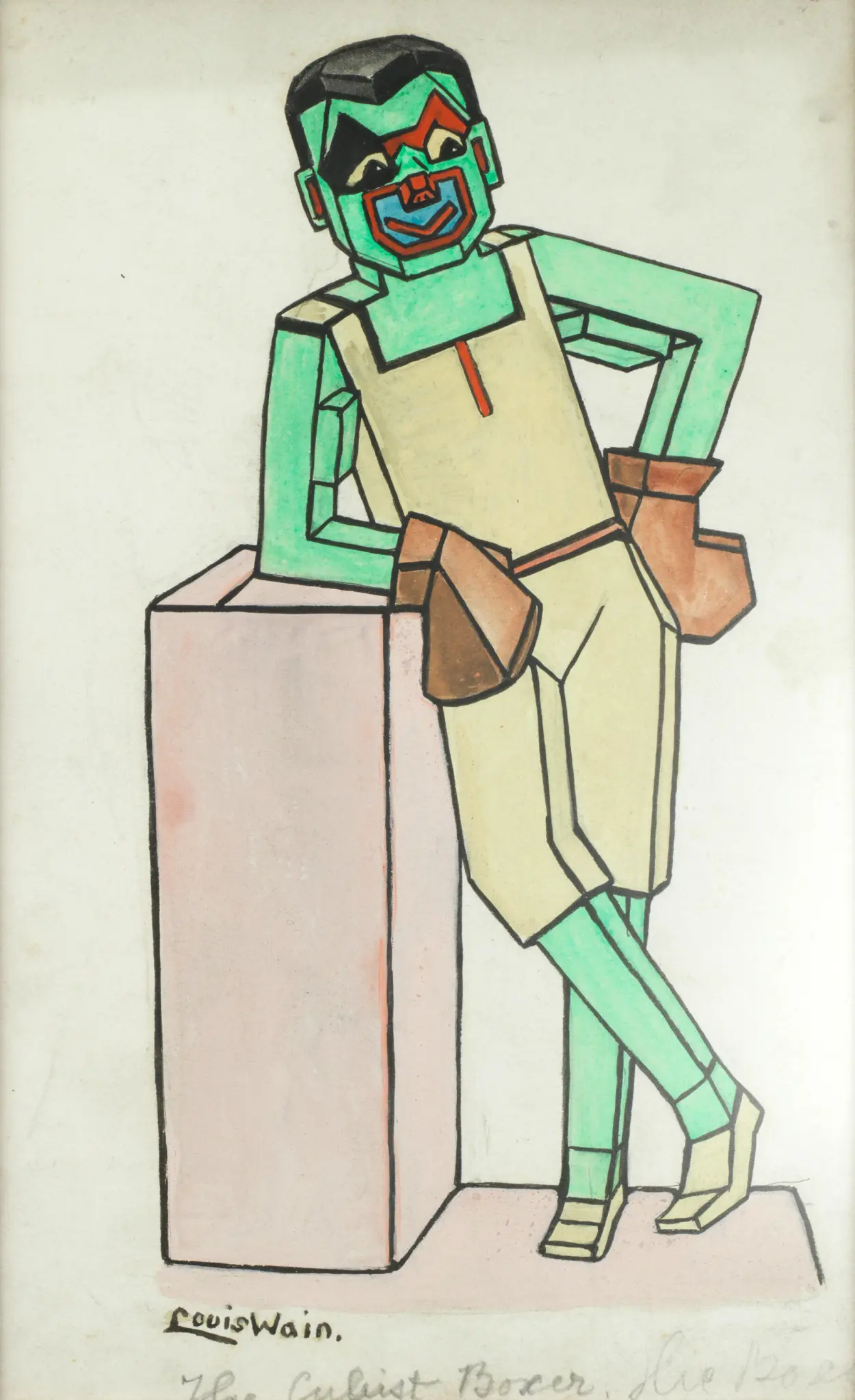
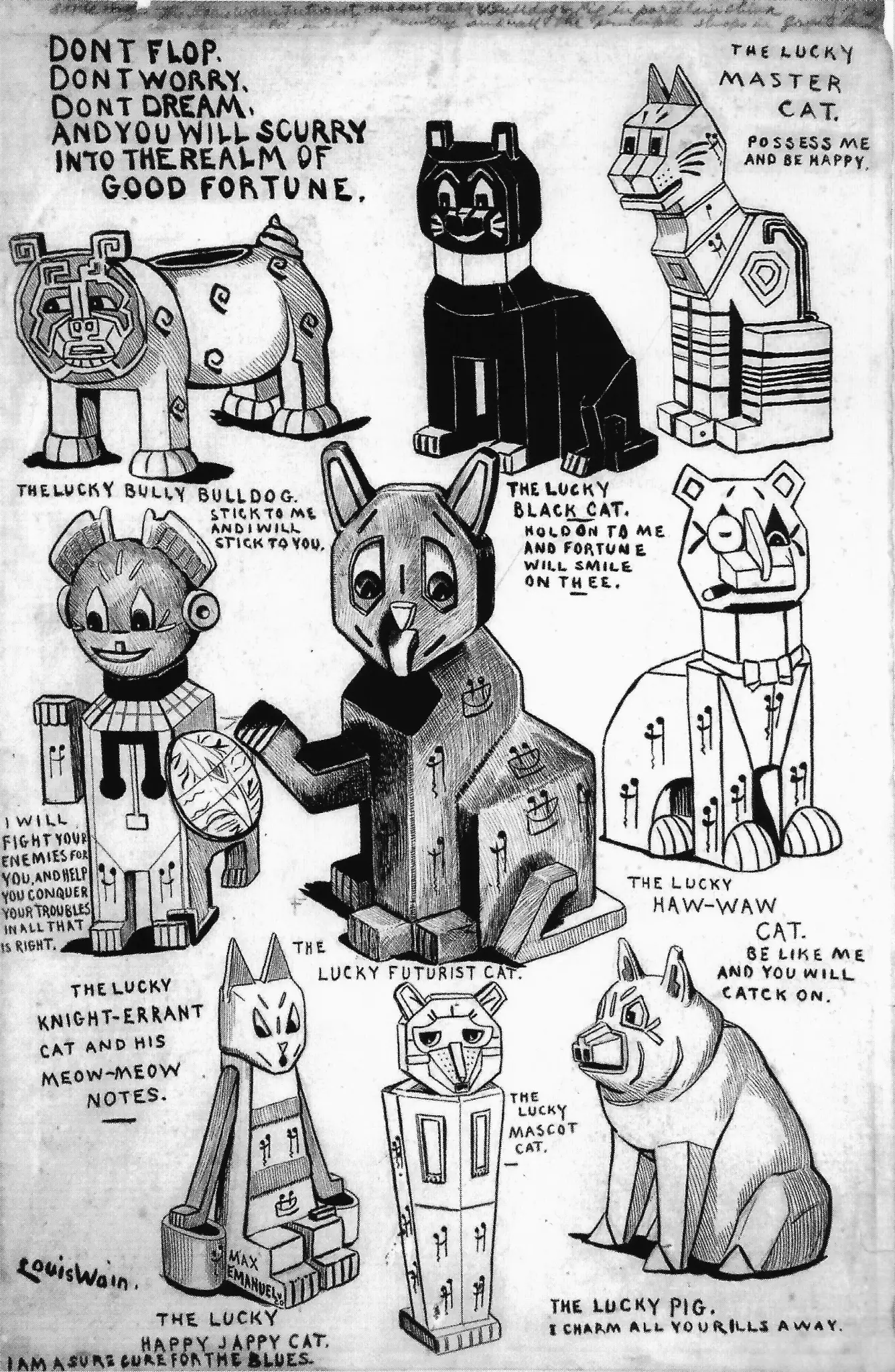





In 1917 Louis created two animations called “The Golfing Cat” and “the Hunter and the Dog” directed by George Pearson and theatrically released in 1917 by Gaumont Studios. Some reports say that they were never finished, others say that they are held away from public viewing, but there is no current way to watch them, sadly 😿.
“The Golfing Cat” notably featured a character named “Pussyfoot”, the first feline representation in cinema, and a character that supposedly resembled Disney’s later Felix the cat animations. Unfortunately for Louis,the rigor it took to produce each frame for a single cartoon, such was the strain of early animation, proved to be too much for him. He abandoned the format, and the animations have since become lost media.
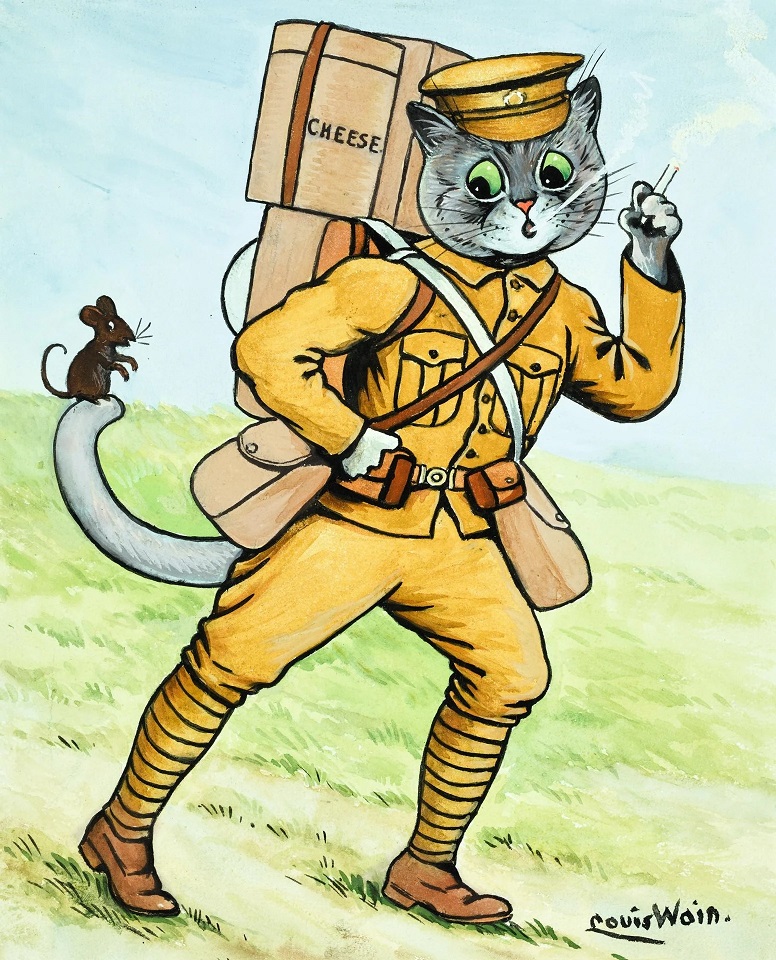
The decline of Louis’s health
1914 would prove to be the start of a devastating decline in Louie’s life. Although his retro ceramic cats proved to be a promising new venture, a missile torpedo would crash into the ship carrying his work, thus destroying all the porcelain animals he dedicated his passion to. World war II brought the threat of poverty upon him. His publishers were forced to cut back on the amount of illustrated materials produced, and since Louie, having poor business skills, never collected royalties, instead depending on outright fees, he quickly saw the decline in his income. To make things worse for him, Louie would suffer a terrible concussion following a severe fall from a bus in 1914. Louis had always been reputed as a strange individual, many would a credit him as the maddened genius, yet his delusional theories and absurd ideals turned to erratic behaviors. The man who once known for his kind and gentle demeanor, soon become violent and erratic in nature, and in 1924 Lewis Wayne was silently admitted to Springfield hospital, a paupers ward (the former surrey county asylum). Louis would stay here for years believing that his once adoring fans had abandoned him, and maybe some had, as he no longer embellished England in the time of war when Edwardian romanticism was hard to perceive. Yet, the following year, a journalist found him.
“Good Lord, man, you draw like Louis Wain.”
“I am Louis Wain”, replied the patient.
“You’re not, you know”, I exclaimed.
“But I am,” said the artist, and he was
A petition for Wain was started by his many admirers, including the Prime Minister Ramsey Macdonald, who arranged for Louis to be transferred to Bethlehem hospital. His sister’s were given a small pension for Louis’s contribution to the arts. At this point, Louis Wains life paralleled another mentally ill English painter, Richard Dadd, a 19th century fantasy Victorian painter mainly preoccupied with fairy like scenery, inspired straight from fantasy books. Although In the year of 1843 any promising career was shattered when he murdered his father in a fit of Hysteria, believing he was the devil. Wain’s own life paralleled the artists when he too was hospitalized in Bethlehem hospital, the same institution Dadd had been held, albeit in a different wings years before. Both of these artists, while institutionalized, would continue to create pieces that marveled the public years later, although during their time they were mostly forgotten. Like Yayoi Kusama, another artist who spent years and is currently still living in a hospital in Tokyo, Louis would find the stolidness of hospital life to begin some his most extraordinary and expressive forms of works, his psychedelic cats. Violet flowers grew from the eyes of grinning cats who’s fur produce electricity. Catland turned into a exuberant world of psychedelic patterns, and sinuous lines. The bucolic backgrounds became less prominent as kaleidoscopic visuals took over.
Despite his illness’s worsening conditions, as well as what would be considered a undesirable environment, Louis’s last years in a psych at ward in many ways had freed him as much as it was a place of struggle. Much of his artistic life was afflicted with struggle and not much amusement, as he was forced to sustain income for his family. Yet being liberated from the constraints of commercial art, he had finally found himself with plenty of time to pursue his fractal experimentation work.He was given the oppurtunity to utilize his creativity. Louis Wain would decorate the halls of Bethlehem during Christmas. His painting on mirrors are still there to this day, such as the one titled “Brown and White Cats with Plum Pudding. Some people note the relation to his mother, a church embroiderer and carpet designer, and the similarity of his later fractal designs to a Persian rugs. You’ll see that there is some resemblance between these designs and his electric cats. Knowing Louis, there is no doubt he would’ve observed something like this enough to leave a lasting impression.
In 1930 Louis was transferred to Napsbury Hospital in St Albany. He would continue to draw all the while his mental health worsened. Exhibits of his works would be held in London in 1931 and 1937. In 1939 July 4th, Louis Wain would pass away, following a stroke. One of the last cat portraits he would draw before his death depicts a white cat with a mischievous grin, beneath it the words “Im happy because everyone loves.” It dispels the sensationalized theory that Louis was no longer able to correctly illustrate a cat. Much people like to spectacle on the meaning of the drawing, whether it was the words of a self-absorbed cat dote with affection, or the appreciative remarks of a man, lost in Catland who wanted to make people smile.
Gallery of Louis’s art


“A Psychotic Cat”

“Untitled”
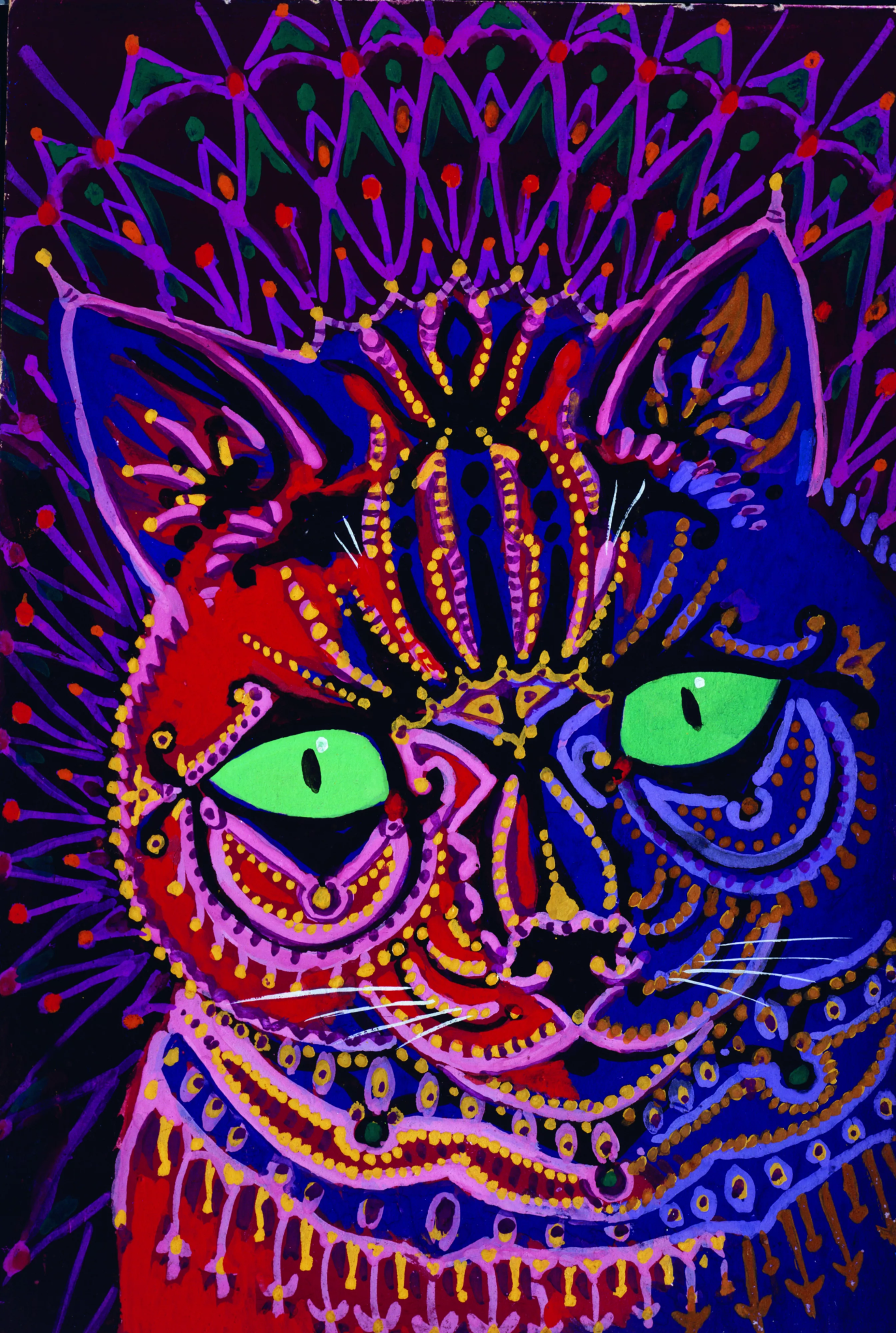
“Untitled”

“Pleasant Daydreams”
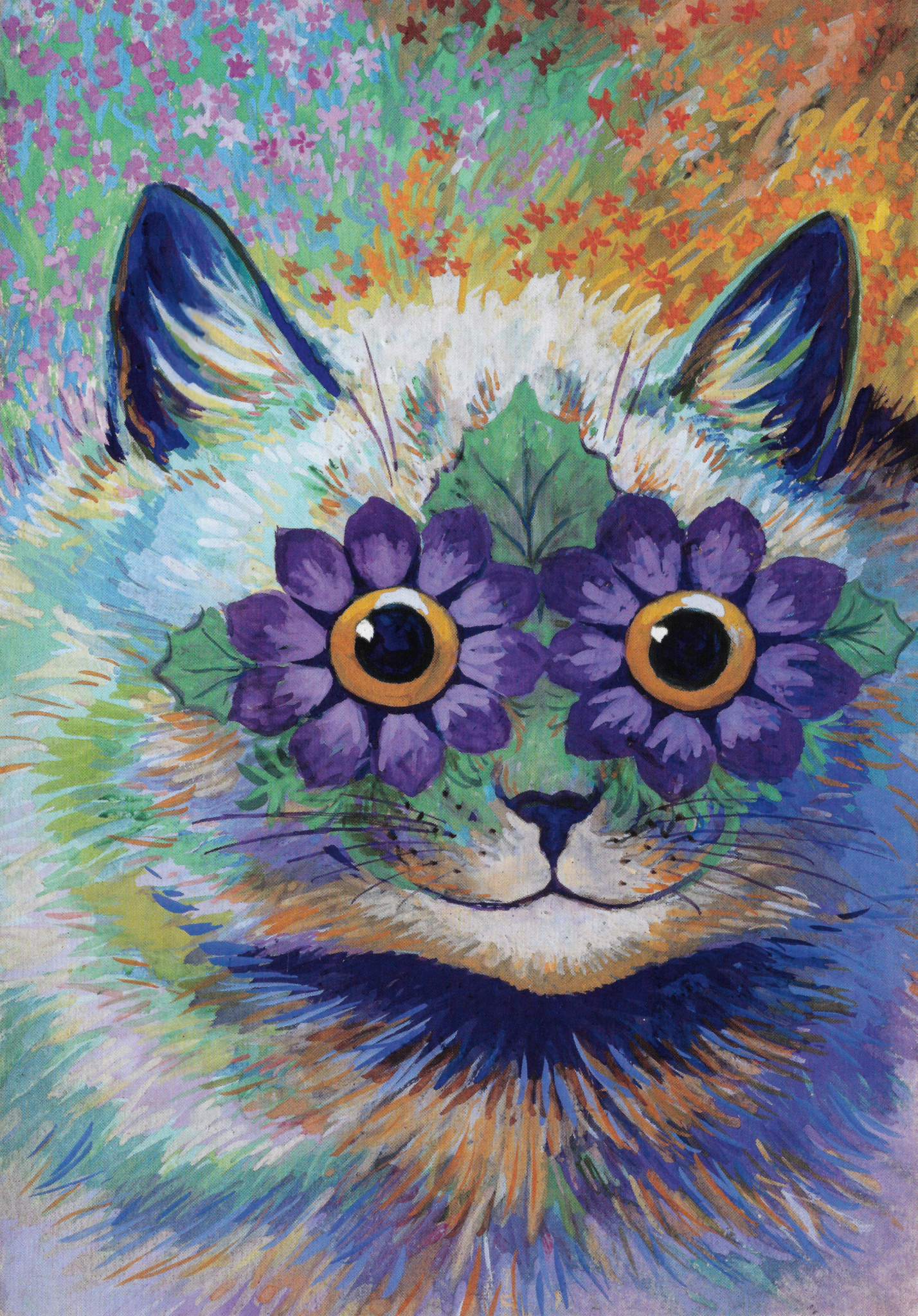
“The Early Indian Irish”
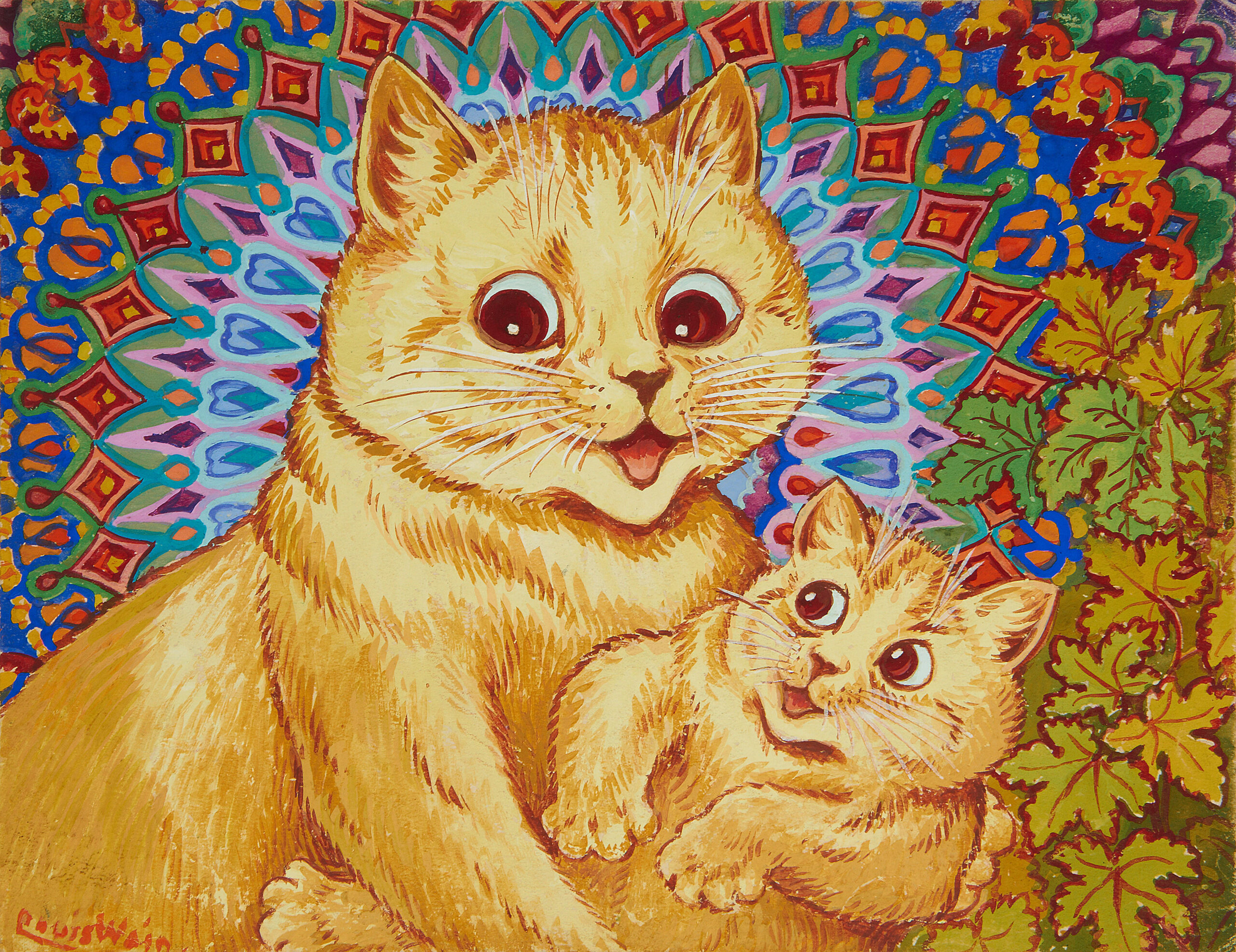
Mother with Kitten
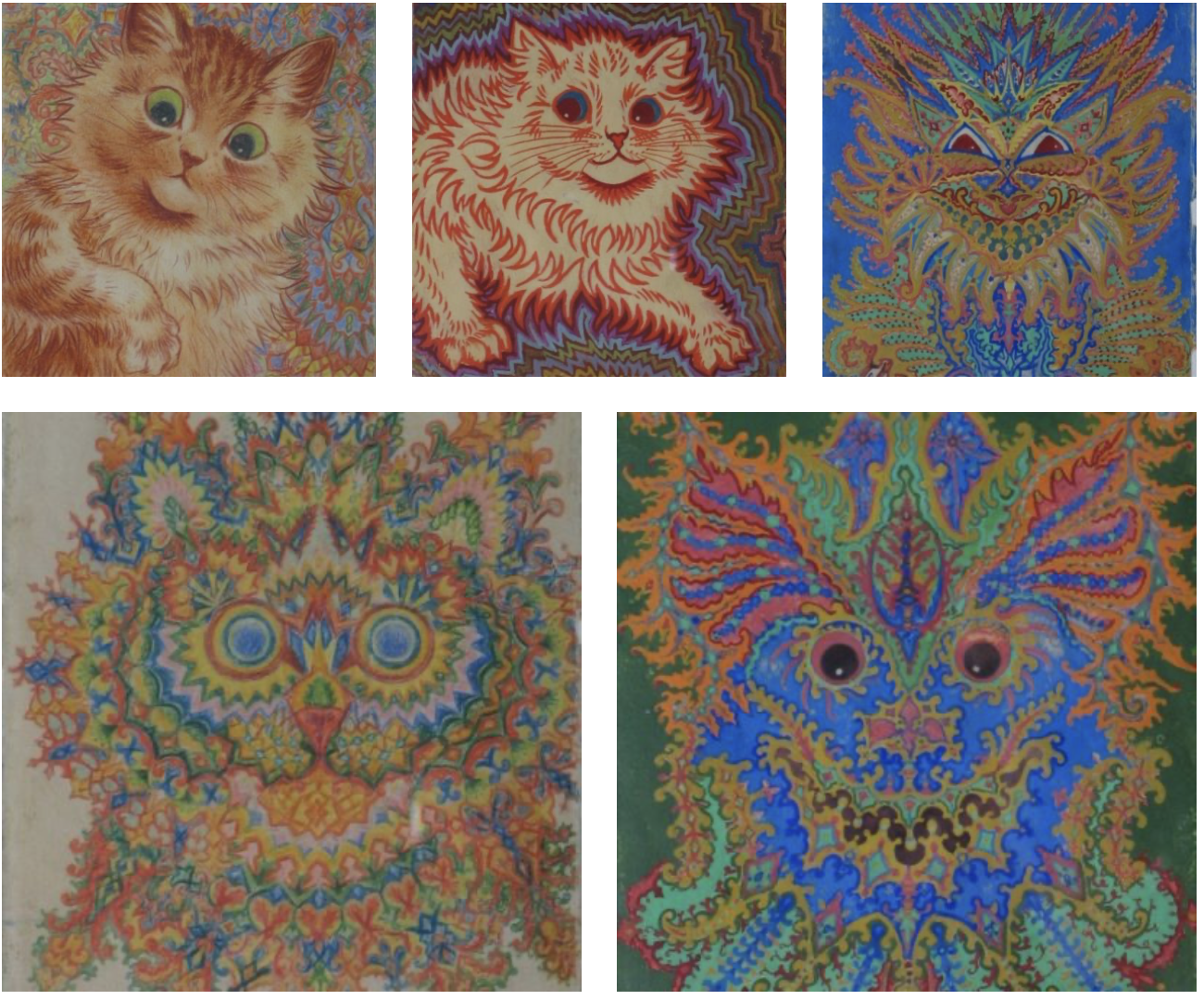

Persian rug from https://behnamrugs.com/different-persian-rug-styles/

“Brown and White Cats with Plum Pudding” one of the mirrors Louis Wain decorated during his time in Bethlam hospital

“I’ll Draw Your Portrait” (1910?)
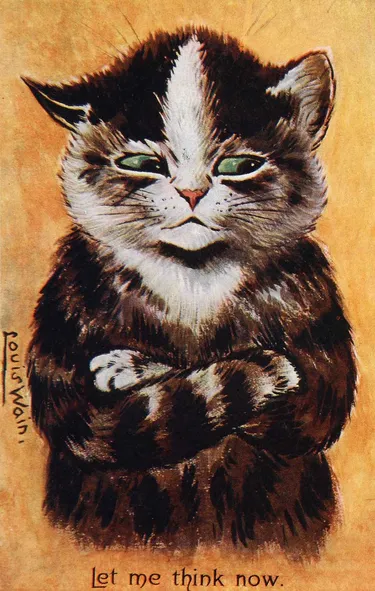
Let Me Think Now (Circa 1910?)

I Won’t! (1910?)

“Three Cats Performing A Song and Dance”





“Everybody’s Loved by Somebody” Louis Wain puzzle.

(This one is so cute and I only discovered it AFTER the whole post)
MEDIA

Oingo Boingo’s self titled debut EP, Released September 17, 1980, By I.R.S Records featuring one of Louis Wain’s eclectic cats on stenciled art.
lucifer sam, siam cat
always sitting by your side
always by your side
that cat’s something i can’t explain!
-Syd Barret
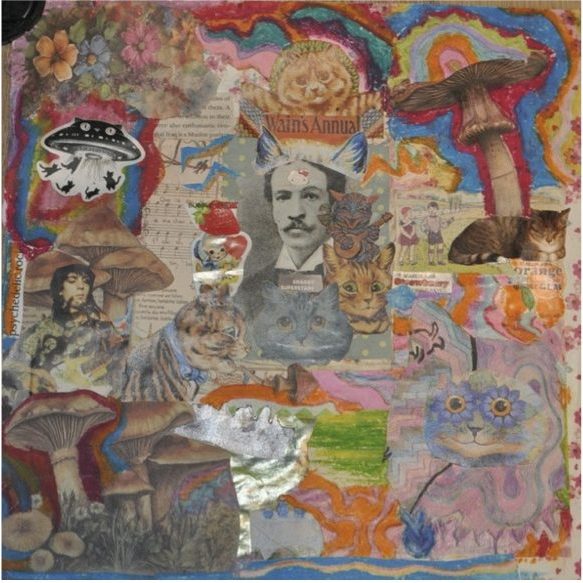
Here is the collage I made in contribution to this post I made for Louis Wain
If you want to know more about Louis Wain, I recommend the Catland site. it’s such an incredible source of archived media and art related to him. (It is listed below)
Links and sources
https://catland.distin.org/ (You can view literally all his art and everything right here. Its amazing)
https://www.britannica.com/art/Art-Nouveau
https://museumofthemind.org.uk/collections/gallery/artists/louis-william-wain
https://www.lookandlearn.com/blog/31454/louis-wain-devoted-his-tragic-life-to-his-dying-wife-and-to-cats/ (circa 1975)
https://www.artsy.net/article/artsy-editorial-colorful-dancing-psychedelic-cats-louis-wain
https://volodymyrbilyk.medium.com/that-time-when-louis-wain-did-futurist-cats-2a6b64e6e736
https://www.chrisbeetles.com/artist/19/louis-wain
https://www.stellabooks.com/illustrator/louis-wain
https://www.aci-iac.ca/art-books/william-kurelek/significance-and-critical-issues/
*
p.s. Hey. (1) The mighty, one and only Darbz has put together a guest post about the legendary cat-centric artist Louis Wain for us, and it’s pleasure incarnate, as you’ve probably already realised by the time you’ve scrolled all way the down here. Thank you so much, Darbz. And the rest of you have several days to make your way through the Wain Fest because … (2) Early tomorrow morning I’m flying to Houston, Texas where I’ll be co-hosting a screening of ‘Room Temperature’ at a film festival there this coming weekend. As always when I take these trips, the blog will be going on vacation until I get back to Paris. In this case, the blog will spring back to life next Tuesday, the 18th. Have the kind of fun that only you can have for the next days, and I’ll catch up with you then. ** Carsten, Hey, bud. Glad the Tyrrell thing sat well with you. Have a festive week. ** BTG, Hi. I’m going to hit the PdT after I get back from Houston plus a few days of jet lag recovery. You like living here? I do. I’m from LA which is kind of maybe like the Marseilles of the US, or at least the Marseilles of California. I live in the 8th (on the border of the 1st) and I can almost see the tip top of the huge dick on my walk to the metro station. I just saw a still from ‘Zone Interdit’ and it’s exactly as you described. I’ll give it a look. Thanks! ** _Black_Acrylic, My pleasure, Mr. R. ** Jack Skelley, Cool beans. Of course I wish you a better attitude but you’re so good at finding the way there yourself. But yes, of course. Wish me uncharacteristically minimal to no jet lag while I’m in Houston. Talk about a tall order. xoxo. ** jay, She’s one of those characters who’s kind of riveting even in really shit films of which she made quite a number. I’ve never read Proust and never will, so I don’t know if he’s my thing or not. He probably is. That TV show is certain to completely rob that game of its nasty silver lining, no? ** Diesel Clementine, Hi! Nice to see you! It’s been a bit. I’m so sorry you’ve been through a rough patch. Even if your husband is overdoing it, he sounds very valuable. I’m glad you’re writing though. My writing has always gotten me through my horrors. The filmed interview for the Edmund White doc seemed to go okay according to the filmers. It’s hard for me to tell. Everything’s going really well with our film so far, thank you. I hope that by the time I get back you’re feeling much closer to how you want to feel. Hang in there, and multi-hugs. ** Charalampos, Brophy is Brigid Brophy. She’s very worth reading. Of course you can email me something — denniscooper72@outlook.com — just keep in mind that I’m very, very slow. Luv from here. ** Dominik, Hi!!! Haha, yes, as is so often the case. I think the first Patti Smith 45 (‘Hey Joe’/Piss Factory’) and ‘Horses’ are great. I think after that the magic was mostly gone. But, no, I mean, Patti Smith is no problem. It’s just that my feed seems to think I’m really, really interested in her but I am really not. Love could do worse than read ‘Exquisite Corpse’ I would say. I’m surprised love hasn’t read it yet. Love hoping Texas lives up to this, G. ** Bill, For sure: her face. I’m suspicious of ‘Bugonia’, yeah, but will probably see it anyway. I wish all the critics would stop encouraging Del Toro to keep going in his recent direction. What is wrong with them?! ** James Bennett, Hi. Haha, no, that’s Kevin mischief. I never stayed in Allen Ginsberg’s apartment and he would never have invited me to, believe me. Have a swell week, and see you before too long at all. ** Steve, Cool. Everyone, Excellent suggestion from Steve: ‘Over on ok.ru, Dmitri Kroitor has posted almost 100 live performances from the French music TV show “Chorus,” which ran from 1978-81. They had very good taste, with clips from Magma, the Ruts, Kraftwerk, James Brown, Magazine, the Clash, Tom Waits, Don Cherry and dozens more.’ Trip stress, I’m knowing that one very well at the moment. Best of luck with yours. Here too: newly wintery. ** HaRpEr //, Hey. She’s quite great in ‘Fat City’. Kind of too bad she never got that kind of opportunity to show her full stuff in a serious context again. I love ‘The Dead’, and I agree. It’s one of the greatest short fiction pieces ever, and yet Huston found a way to represent it and even the devastating ending. Amazing. Keep the faith about your manuscript and always keep in kind how utterly subjective and based on extenuating, totally non-artistic factors that publishers’ decisions usually are. ** Laura, She (Tyrrell) was a wild one. She was around a lot in the kind of alternative punk/drag/etc. scene in LA and everybody knew her peripherally at least. Yeah, that Ozu is unbelievable. Immediately jumped into my favorite films list. My favorite Ozu is still ‘Late Spring’, but still. His greatness is inspiring and intimidating. Should you read Edmund White? I guess if you want to know what it was about his work that made a lot of people declare that he was ‘the great American gay writer’ then why not? I’m almost ready for my trip. It’s early tomorrow. Okay, cool, on what you’ll send. Just to reiterate how slow I am. I don’t remember the Wernher Von Braun quote. My dad was friends with Von Braun weirdly. High hopes that your reprieve persists. Love back. ** Uday, Hi. If you hadn’t watched our films, you’d still be totally cool. I’m not against music in others’ films as long as it isn’t used to smother a film that wouldn’t be much without it. I do pause on the fail videos when they come through my feed. I don’t know, their pleasure is extremely fleeting to me. For some reason my current go-to feed junk are these videos of this guy who goes to restaurants and buys tons of food and then goes and gives it to the homeless. I guess I’m in a mood for kindness or something. Stay on fire. ** Okay. Spend some quality time with Louis Wain and Darbz’s curatorial finesse, and leave whatever comments you like in the next days, and I will put something new in front of you and talk with you in just about a week. Take care.




 Now available in North America
Now available in North America 
Leave a Reply